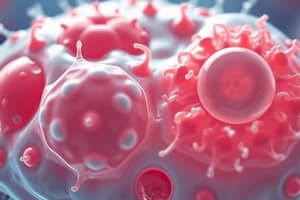Podcast
Questions and Answers
What is the importance of cellular organization in organisms?
What is the importance of cellular organization in organisms?
Disruption can lead to disease or death.
Define responsiveness in organisms.
Define responsiveness in organisms.
It is an organism's ability to sense changes in the environment and adjust to them.
Explain the concept of growth in organisms.
Explain the concept of growth in organisms.
Growth refers to an increase in the size or number of cells leading to enlargement of the organism.
What is the significance of human metabolism in biological processes?
What is the significance of human metabolism in biological processes?
Describe the process of development in organisms.
Describe the process of development in organisms.
Why is reproduction important for the survival of species?
Why is reproduction important for the survival of species?
What are the main components of the urinary system?
What are the main components of the urinary system?
What is the primary function of the male reproductive system?
What is the primary function of the male reproductive system?
Which structures are involved in the exchange of gases in the respiratory system?
Which structures are involved in the exchange of gases in the respiratory system?
What are the main components of the female reproductive system?
What are the main components of the female reproductive system?
What is the overall function of the urinary system?
What is the overall function of the urinary system?
What is the role of the male ducts and glands in the male reproductive system?
What is the role of the male ducts and glands in the male reproductive system?
What is the main function of the integumentary system?
What is the main function of the integumentary system?
How does the muscular system contribute to maintaining posture?
How does the muscular system contribute to maintaining posture?
What is the primary function of the skeletal system?
What is the primary function of the skeletal system?
Describe the role of the nervous system in the body.
Describe the role of the nervous system in the body.
How does the endocrine system regulate various processes in the body?
How does the endocrine system regulate various processes in the body?
Explain the significance of the cardiovascular system in the human body.
Explain the significance of the cardiovascular system in the human body.
What is the term used to describe the maintenance of relatively stable internal conditions in the body?
What is the term used to describe the maintenance of relatively stable internal conditions in the body?
When there is a change in altitude, what happens to the air at higher altitudes?
When there is a change in altitude, what happens to the air at higher altitudes?
How does the body react to changes in internal conditions during homeostasis?
How does the body react to changes in internal conditions during homeostasis?
What type of feedback reduces the effect of a stimulus in the body?
What type of feedback reduces the effect of a stimulus in the body?
What is the primary purpose of homeostasis in the body?
What is the primary purpose of homeostasis in the body?
How does altitude affect the difficulty of breathing?
How does altitude affect the difficulty of breathing?
What is the main purpose of negative-feedback mechanisms in the body?
What is the main purpose of negative-feedback mechanisms in the body?
Define 'Receptor' in the context of negative-feedback mechanisms.
Define 'Receptor' in the context of negative-feedback mechanisms.
Give an example of a type of receptor that detects changes in temperature.
Give an example of a type of receptor that detects changes in temperature.
What is an effector and its role in negative-feedback mechanisms?
What is an effector and its role in negative-feedback mechanisms?
Name a type of receptor that is sensitive to changes in forces or pressures.
Name a type of receptor that is sensitive to changes in forces or pressures.
What do chemoreceptors detect changes in, making them very sensitive to oxygen levels?
What do chemoreceptors detect changes in, making them very sensitive to oxygen levels?




